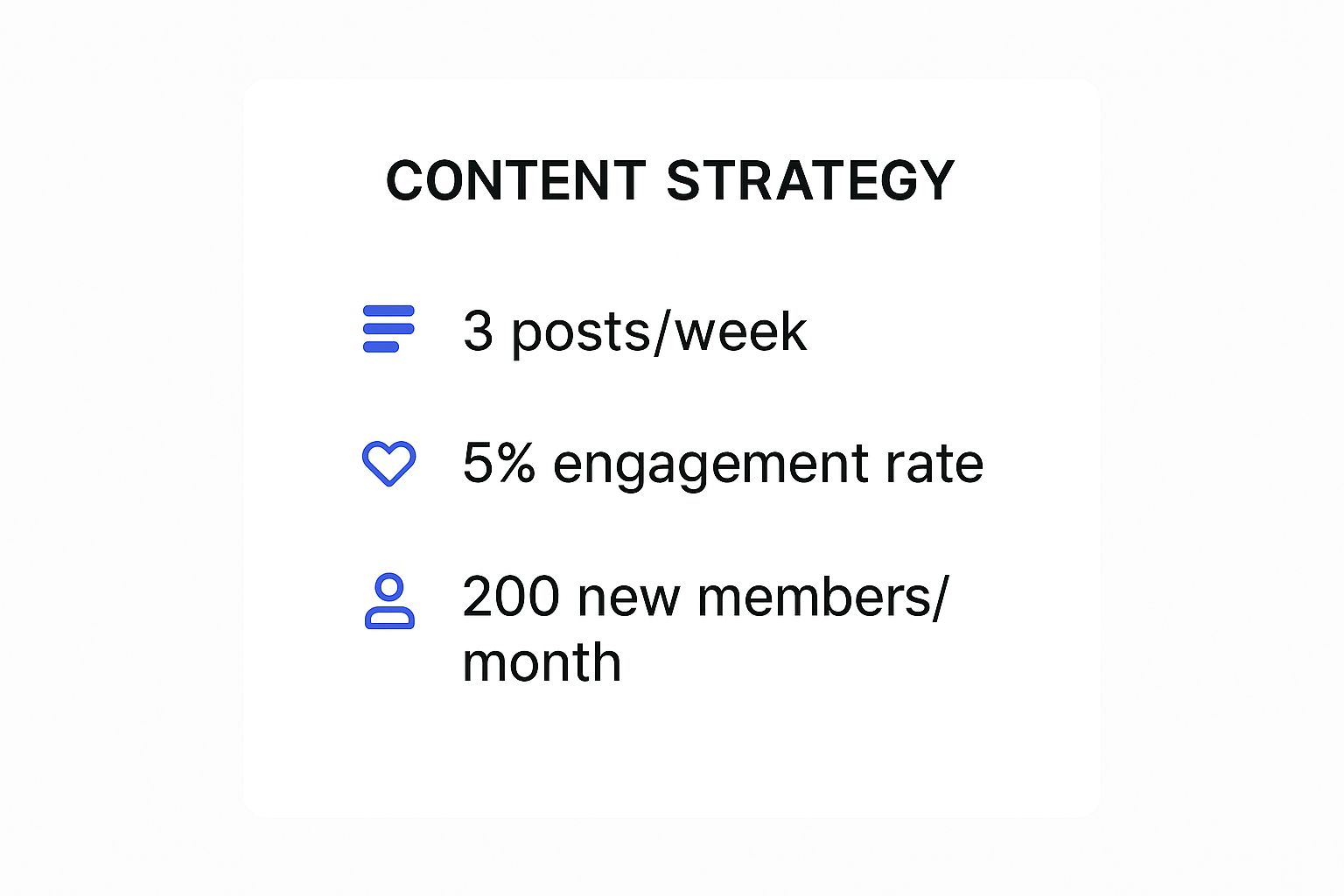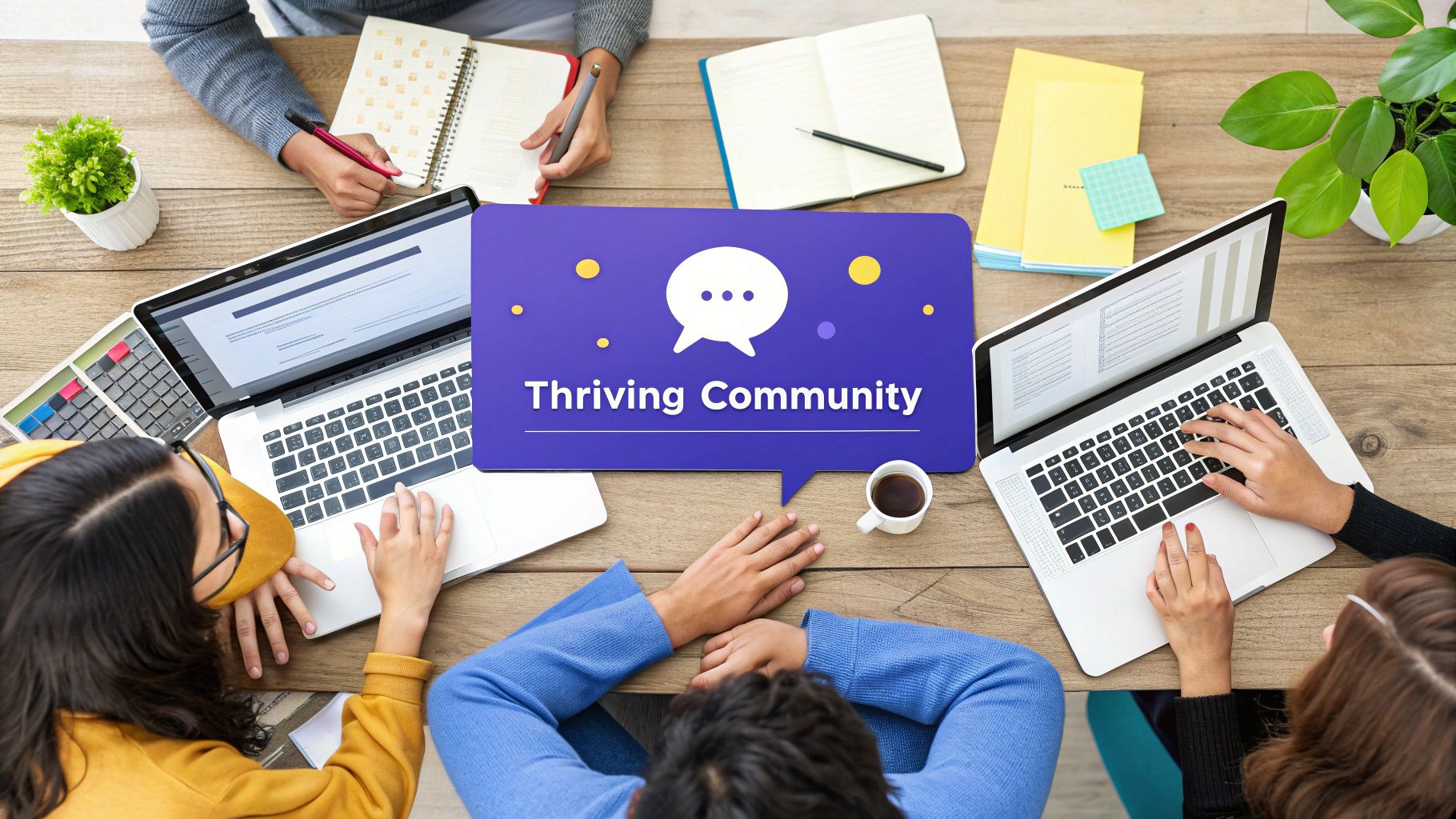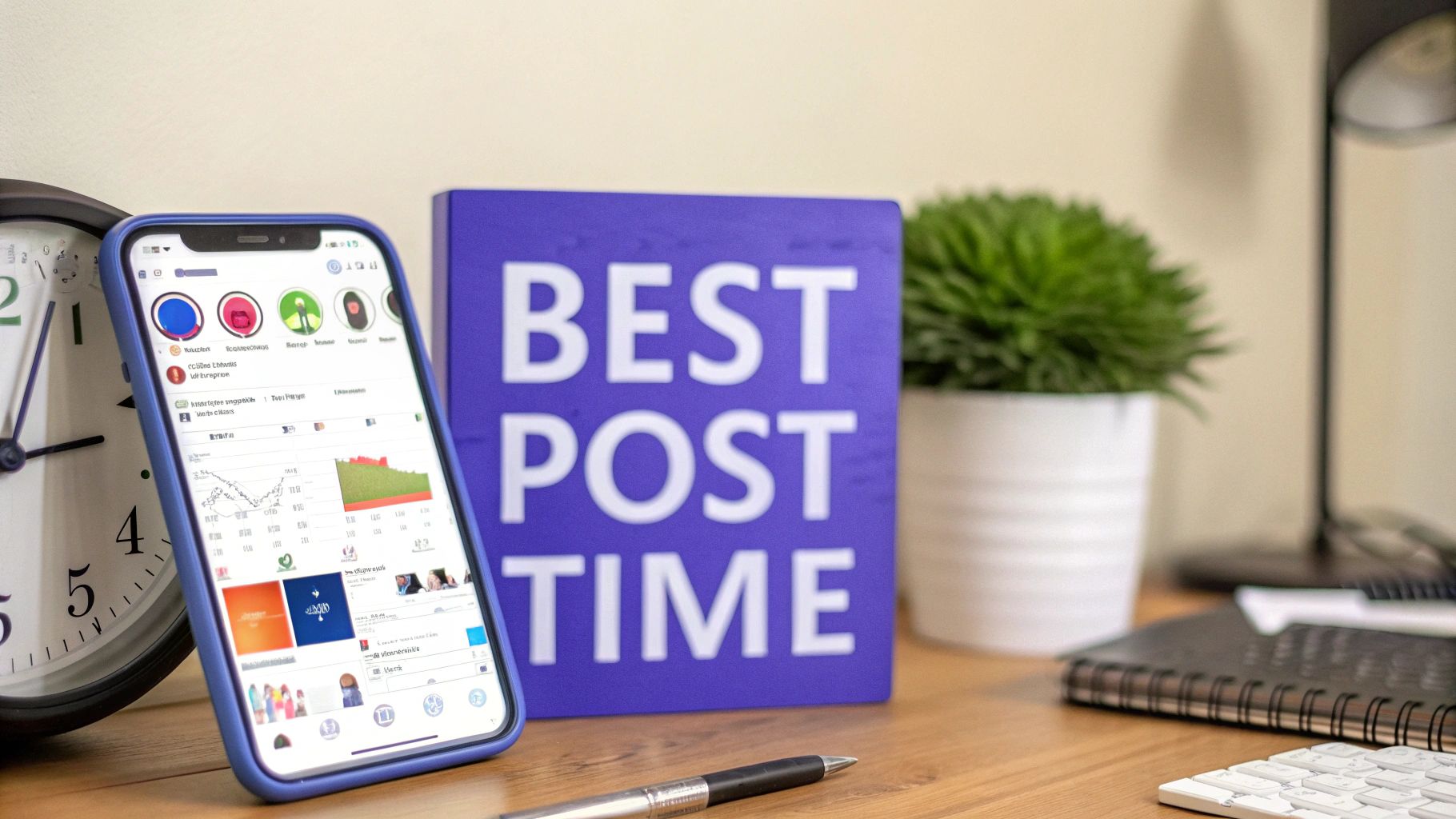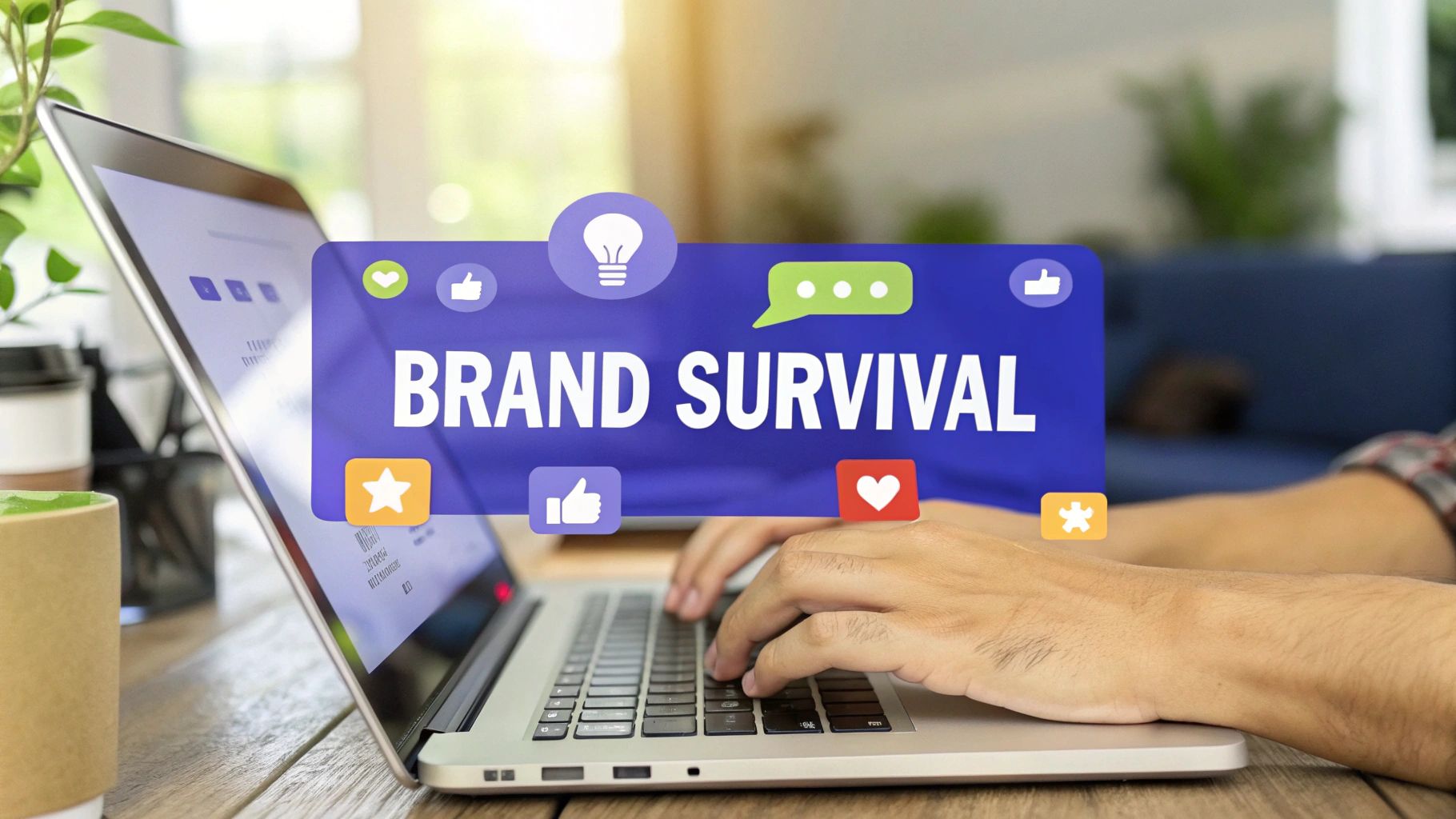Let's get one thing straight from the start: building an online community isn't about collecting a list of passive followers. It's about gathering a group of people who are genuinely fired up about a shared interest. This is the absolute first—and most important—step in figuring out how to build an online community that actually lasts. You have to shift your mindset from broadcasting messages at people to sparking real connections between them.
Why a Community Is More Than Just an Audience

So many brands fall into the trap of thinking their social media following is their community. It’s a common mistake, but a critical one. An audience consumes your content; a community helps create it. That single distinction is the foundation of long-term, sustainable growth.
Think of it this way. An audience member might toss a "like" on your post. A community member, on the other hand, dives into the comments, shares their own related story, and even starts answering questions from other people in the group.
It’s the difference between a lecture and a workshop. In a lecture, information flows in one direction. But in a workshop? Everyone’s hands are dirty. People are participating, learning from each other, and walking away feeling like they built something together. That’s the energy you're trying to capture.
The Power of Active Participation
The real magic happens when members feel like they have a voice and the permission to use it. This active participation is what separates a true community from a basic social media page.
The data tells a compelling story. While typical social media platforms see engagement rates hovering somewhere between 0.5% and 5%, dedicated online communities can boast active participation from around 48% of their members. This isn't just a vanity metric—it has a real impact on the bottom line. In fact, 66% of professionals confirm their communities have directly and positively impacted customer retention.
When you foster this kind of involvement, your brand transforms. You stop being a faceless company and become the central hub where people connect. They aren't just buying your product anymore; they're joining a movement they care about and feel invested in.
A community acts as a powerful asset, driving customer loyalty, organic word-of-mouth, and direct product insights that paid ads can't replicate. It builds a protective "moat" around your brand.
From Transactional to Relational
An audience typically has a transactional relationship with you. They follow you for discounts, announcements, or maybe some light entertainment. A community, however, builds a relational bond.
Members feel connected not just to your brand, but to each other. This creates an incredible network effect where the community becomes more valuable with every new person who joins and engages.
This shift delivers some serious benefits:
- Drives Loyalty: Members who feel like they belong are fiercely loyal customers.
- Generates Insights: An active community is the ultimate focus group, giving you a firehose of unfiltered feedback and brilliant ideas.
- Creates Advocates: Your most passionate members become your best marketers, spreading the word simply because they love what you've all built together.
If you want to go deeper on this, particularly how it applies in the e-commerce world, check out this fantastic guide on building a high-growth DTC community. The journey begins the moment you realize your goal isn't just to gather followers, but to build them a home.
Laying the Foundation for Your Community

A vibrant online community never just springs up on its own. It's built brick by brick, with intention and a clear sense of direction. Before you start picking platforms or brainstorming content ideas, you need to go back to the very beginning and answer one crucial question: Why should this community exist?
Your answer to that question is what I call your "Big Purpose." Think of it as the North Star guiding every single decision you make from here on out. Are you building a support network for first-time parents? A mastermind group for freelance designers? Or maybe a space where fans of a niche video game can geek out over strategies? Without this clarity, your community will lack focus and won't attract the right people.
Once you’ve nailed down your purpose, it’s time to define your ideal member. And I mean really get specific. Instead of just "gardeners," narrow it down to "urban gardeners in small apartments." This laser focus makes it infinitely easier to create content and experiences that genuinely connect.
Defining Your Core Values and Guidelines
The culture of your community is defined by its values and the rules you set. These aren't just bureaucratic red tape; they are the essential guardrails that keep your space safe, welcoming, and productive. They’re the shared understanding that holds the entire thing together.
For instance, a community for software developers might revolve around values like "collaborative problem-solving" and "constructive feedback." On the other hand, a mental health support group would naturally prioritize "empathy" and "strict confidentiality."
The best guidelines are simple, clear, and proactive. They shouldn't just list what's forbidden; they should actively describe the kind of positive behavior you want to see.
Drafting these early on sets the tone from day one. It helps attract members who are a great fit for your vision while gently discouraging those who aren't. This is a vital part of building a self-sustaining online community. For a more structured way to tackle this, our social media marketing strategy template can help you organize these foundational pieces.
Setting Tangible Goals
Your "Big Purpose" is the vision, but goals are the measurable steps that get you there. Setting clear, tangible objectives is how you track progress and, just as importantly, prove the community's value over time. These goals should flow directly from your purpose.
Think about what success actually looks like for you:
- Support-Focused: Maybe your goal is to decrease support tickets by 15% in six months by empowering members to help each other.
- Networking-Focused: You could aim to facilitate 50 new professional connections or collaborations among members each quarter.
- Advocacy-Focused: How about generating 200 pieces of user-generated content (UGC) each month to feature in your marketing?
The potential audience out there is massive. As of early 2025, there are 5.56 billion internet users, and a staggering 5.24 billion of them are active on social media. This just underscores why having a targeted strategy is so critical—you need to attract the right slice of that enormous pie. All this foundational work ensures your community launches with a clear purpose, a strong culture, and a defined path to success.
Choosing the Right Home for Your Community
Okay, you've nailed down your community's "why" and its core values. Fantastic. Now comes the big question: where is this community actually going to live? This isn't just a technical detail; it's a decision that will shape every single interaction your members have, from the moment they join to their daily conversations. Think of it as choosing the architectural plans for your community's home.
The sheer number of options can feel a bit much, but they really fall into three main buckets. Each one has its own set of trade-offs when it comes to control, features, and the overall vibe you're trying to create. The best choice for you hinges entirely on your goals and the specific culture you want to build.
Dedicated Community Platforms
This is your all-in-one, purpose-built category. I'm talking about powerful solutions like Circle or Mighty Networks. These platforms are designed from the ground up for community building, packing in everything from discussion forums and event calendars to member directories and even course hosting.
The single biggest win here is ownership and control. You own your member data. You control the branding. Most importantly, you aren't at the mercy of some social media algorithm that could flip a switch and kill your reach overnight. This independence lets you create a much more focused, premium experience for your members, away from the endless noise and distractions of a public feed.
Here’s a great example of what a dedicated platform like Circle can look like. Notice the clean, branded layout.

It’s a curated space that’s all about the community, which does wonders for keeping members focused and engaged.
Social Media Groups and Chat Apps
This is the path of least resistance. Using familiar territory like Facebook Groups, LinkedIn Groups, or real-time chat apps like Discord and Slack. The main appeal is pure convenience. Your members are probably already using these platforms every day, which makes getting them to join feel almost effortless.
But that convenience comes with some serious strings attached. You have zero control over your data, your customization options are slim to none, and you're in a constant battle for attention against a firehose of other notifications. Trying to monetize your community here often involves clunky, unprofessional workarounds.
Choosing a platform is a classic balancing act: meet your members where they are, but don't forget to build the focused, valuable space they truly deserve. Never sacrifice long-term value for short-term convenience.
Community Platform Feature Comparison
So, how do you decide? This table breaks down the key differences between the main platform types to help you match features to your specific goals.
| Feature | Dedicated Platforms (e.g., Circle) | Social Media Groups (e.g., Facebook) | Chat Apps (e.g., Discord) |
|---|---|---|---|
| Control & Ownership | Total control over data, branding, and features. | No control; subject to platform rules and algorithms. | Limited control; data owned by the platform. |
| Monetization | Built-in tools for subscriptions, courses, and paywalls. | Difficult; requires third-party workarounds. | Limited; some support for server subscriptions. |
| Customization | Highly customizable to match your brand identity. | Very limited; basic branding options. | Some customization with roles and channels. |
| Member Experience | Focused and premium; no ads or external distractions. | Distracting; competes with news feeds and ads. | Fast-paced and informal; can be overwhelming. |
| Discovery | Challenging; requires external marketing to attract members. | Easier; leverages the platform's existing user base. | Moderate; relies on invites and server discovery. |
| Best For | Professional networks, paid memberships, courses, brand communities. | Casual hobby groups, local communities, initial testing. | Gaming communities, real-time collaboration, fan groups. |
Ultimately, the right choice depends on your vision. If you're building a casual book club, a Facebook Group might be perfect. But if you're creating a premium mastermind for professionals, the structure and focus of a dedicated platform will be invaluable.
Think about it this way: a group of gamers might absolutely thrive in the fast-paced, informal chaos of a Discord server. But a high-ticket professional mastermind? That group needs the structured, premium environment of a dedicated platform where members can easily find high-value content without getting lost in the noise.
This all comes back to your community's purpose.
- For deep engagement, monetization, and brand control: A dedicated platform is almost always the way to go.
- For a casual, low-friction gathering spot: A social media group or chat app can be a great place to start.
My final piece of advice? Think long-term. It’s incredibly tempting to just fire up a free Facebook Group because it's easy. But trust me, migrating an established community from one platform to another is a massive headache you want to avoid. Choose the right home from day one, and you'll set yourself up for sustainable growth and a far better experience for everyone involved.
Launching Your Community and Getting Traction

This is the moment all your planning leads up to. A great launch sets the tone and builds the initial energy that will propel your community forward for months to come. But a successful liftoff isn't just about unlocking the doors and hoping people show up. It's a carefully orchestrated event designed to create instant momentum.
The biggest fear every community manager has is launching to an empty room. To avoid that dreaded digital silence, you need to seed your community with content before anyone arrives. Think of it as setting the stage. Pre-load it with a few conversation starters, some valuable resources, and maybe an interesting question or two. When your first members walk in, they need to see signs of life, not a blank canvas.
This is your first, best chance to establish your community's vibe. For instance, if your community is for freelance writers, you could start with threads like, "What's the one tool you can't live without?" or "Share your biggest client win from last week." This immediately shows people what the space is for and invites them to jump right in.
Recruiting Your Founding Members
Your first 10 to 20 members are, without a doubt, the most critical people in your community’s entire lifespan. These are your founding members, the pioneers who will help you build the culture from the ground up.
Forget mass emails. Instead, personally invite the most engaged people from your existing audience. I’m talking about the ones who always reply to your newsletters, leave thoughtful comments on your blog, or have sent you positive feedback in the past.
A personal invitation makes them feel seen and valued. In your message, explain why you're reaching out to them specifically and share your vision for the community. These first members aren't just users; they're your co-creators. If you're looking for more ways to find and attract these key people, exploring different social media growth strategies can give you some powerful outreach tactics.
Your goal isn't to get 100 members on day one. Your goal is to get 10 members who are genuinely excited to be there and participate. Quality over quantity is the rule, especially at the start.
Your First 90 Days of Engagement
Once your founding members are in, your focus needs to shift entirely to engagement. The first 90 days are all about establishing habits and sparking those crucial member-to-member connections. Think of yourself as the host of a three-month-long welcome party.
Here's a simple framework to guide you through those critical first few months:
- Create Welcome Rituals: Start a dedicated "Introductions" thread and make a point to personally welcome every single new member. Go a step further by tagging other members who might share their interests to get conversations started immediately.
- Host a Kickoff Event: Within the first month, put a low-key virtual event on the calendar. It could be a "Founder's Q&A" or a "Community Goals" workshop. Getting people together in real-time is a powerful way to strengthen their sense of belonging.
- Be the Connector: Actively look for chances to connect people. If one member asks a question about a specific tool, tag another member you know has experience with it. Publicly celebrate member contributions to encourage more of the same.
This initial period is all about hands-on, high-touch interaction. You are the host, making introductions and making sure everyone feels welcome. It's an intensive effort, but it's what builds the cultural foundation for a community that can eventually thrive on its own.
Keeping Your Community Engaged and Active
Getting that initial surge of growth is an incredible feeling, but it’s just the starting line. The real marathon is keeping your community healthy and active for the long haul. This is where the real work begins, shifting your focus from launching to daily nurturing.
It’s all about creating an environment where people feel seen, heard, and genuinely excited to show up. Think of yourself less as a manager and more as a facilitator. Your job is to get the ball rolling, but the magic happens when members start connecting with each other.
Sparking Authentic Conversations
To get people talking, you have to move beyond generic prompts like "Happy Friday!" You need to ask compelling, open-ended questions that tap into your members' own experiences and knowledge.
For example, a community for photographers could ask, "What's a recent photo you took that you're proud of, and what was the story behind it?" This isn't just a prompt; it's an invitation for members to share their passion and connect on a personal level.
Another powerful tactic is to run member spotlights. Highlighting someone's project, journey, or expertise makes that person feel incredibly valued. It also gives everyone else a reason to engage and learn from a peer. It sends a clear message: this community is about its people, not just your brand.
The best communities are the ones where members feel a true sense of ownership. When they see their contributions celebrated, they become far more invested in the group's collective success.
Empowering Your Most Passionate Members
As your community scales, you simply can't be everywhere at once. That's okay, because your most valuable assets are your most passionate members—the people who consistently show up, help others, and champion your community’s values. These are your future leaders.
Your job is to identify these champions and give them ways to shine. You could create an "ambassador" role with special recognition or give them early access to new content. This not only rewards your best members but also helps you scale everything from moderation to content creation.
Here are a few ideas to get you started:
- Collaborative Challenges: Run a weekly or monthly challenge with a shared goal, like a "30-Day Content Creation Challenge" for a group of marketers.
- Gamified Participation: To keep things exciting, consider using tools that offer a community quests API. This can gamify participation and reward members for their contributions in a fun, structured way.
- Member-Led Events: Encourage your most active members to host their own virtual meetups or workshops, and provide them with the support they need to succeed.
These strategies are crucial for maintaining momentum. In fact, many of the same principles for building community engagement apply to social media, which you can read more about in our guide on how to improve social media engagement.
Looking ahead, the very definition of community is evolving, especially with the rise of Web3 technologies. New models are emerging that give members collective ownership and governance power, moving away from a single, central authority. By keeping your community active and engaged today, you’re not just building a group—you’re building a foundation that’s ready for whatever comes next.
Common Questions About Building an Online Community
Starting an online community is exciting, but let's be real—it also comes with a lot of questions. If you're new to this, you're probably wondering what you're really getting into. Getting a handle on these common challenges from day one can save you a world of headaches and put you on the right track.
Let's dive into some of the questions I hear most often from people just starting out.
How Much Time Does It Take to Manage a Community?
This is the big one, and the honest answer is: it depends on what stage you're at. The time commitment isn't static; it changes as your community grows.
When you're first getting things off the ground, you need to be all in. I'd block out at least 10-15 hours per week. This is the hands-on phase where you’re creating content, personally welcoming every new member, and striking the match to get those first conversations lit. It's a grind, but it's essential.
As your community finds its footing and members start creating their own discussions, you can often pull back a bit to a more sustainable 5-10 hours per week. Your job shifts from being the host of the party to being the architect of the venue. You'll focus more on high-level strategy, empowering your most active members, and gentle moderation.
A common mistake is underestimating the initial time investment. The first 90 days are critical for setting the cultural tone and require your dedicated presence to build momentum.
What Are the Biggest Mistakes to Avoid?
Every community builder stumbles, but some pitfalls are so common it's almost a rite of passage. If you can sidestep these, you’re already way ahead of the curve.
Here are the three biggest missteps I see people make over and over again:
- Lacking a Clear Purpose: If you can't explain why your community exists in a single, compelling sentence, you have a problem. A fuzzy purpose leads to an unfocused community that attracts the wrong people and fizzles out fast.
- Inconsistent Engagement from You: If the community manager is a ghost, members get the message loud and clear: this place doesn't matter. Your presence, especially in the beginning, is the fuel. It's simply non-negotiable.
- Prioritizing Member Count Over Quality: It’s so tempting to chase big numbers, but this is a classic vanity metric trap. A hundred silent, disengaged members are worthless compared to ten people who are passionate, active, and invested. Quality over quantity isn't just a nice phrase; it's the secret to a strong culture.
Your first goal should always be to deliver incredible value to a small, core group of your ideal members. Get that right, and growth will follow.
How Should I Handle Conflict or Difficult Members?
Put a group of passionate humans together, and eventually, there will be friction. It's not a matter of if but when. The goal isn't to prevent conflict entirely—that's impossible—but to manage it with grace and confidence.
Your best defense is a good offense: have a set of clear, public community guidelines. This gives you a neutral document to point to when things get heated, taking the personal element out of moderation.
When a conflict does pop up, act quickly. Don't let it fester. Your swift action shows everyone else that you're paying attention and are committed to keeping the space safe. A brief public acknowledgment might be okay to show you're on it, but the messy work of resolution should almost always happen in private DMs.
Always give the person a chance to share their side of the story before you act. But if someone repeatedly breaks the rules after a warning, you have to be willing to remove them. Protecting the health and psychological safety of the entire community is your top priority. Be fair, but don't be afraid to be firm.
Ready to streamline your community's content strategy and engagement? PostSyncer provides the tools you need to schedule content, analyze performance, and manage all your social profiles from one place. Start your free 7-day trial today!















